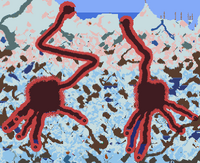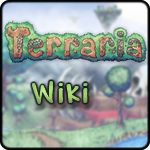Template:PC-Console only

Two Crimson chasms.
The Crimson is a hazardous surface biome that presents a red gore theme. It may exist somewhere in a generated world, generally far from a player's original spawn point. It is the counterpart to the Corruption biome's diseased wasteland theme. A generated world will contain only one of the two, chosen at random during world creation, each with a 50% chance of occurring. The two contain similar hazards, though the Crimson is often considered by players to be the more difficult of the two. Each have their own unique respective enemies, items, and blocks. The tools, weapons and armor obtained via Crimson materials have minor advantages over those obtained via Corruption materials. New players should avoid The Crimson due to its difficulties.
As with the Corruption, the Crimson contains multiple Chasms, deep pits in the ground that lead to underground tunnels. Unlike the Corruption's vertical drops, the chasms in the Crimson cut at angles into the terrain, lead to large circular cavities, then branch off into smaller veins that lead to Crimson Hearts. Crimson Hearts are the Crimson counterpart to the Corruption's Shadow Orbs, and can be destroyed to achieve various effects that advance gameplay (see Crimson Heart for details).
Crimtane Ore can be collected in order to craft various advanced items, like the Corruption's Demonite Ore. Crimson Altars are found underground, which primarily come into play once a world enters Hardmode, though they also function as Crafting Stations for a few items; these operate identically to the Corruption's Demon Altars.
The Brain of Cthulhu is a Boss that can be encountered in the Crimson, and is the Crimson counterpart to the Corruption's Eater of Worlds; though it is slightly more difficult to defeat.
Crimson spreads in the same manner as Corruption, replacing Grass with Crimson grass, and in hardmode, replacing Sand with Crimsand, Stone Blocks with Crimstone, and the Underground Crimson is formed.
Contents
NOTE : View Underground Crimson for the mobs that spawn during Hardmode in and under the cavern layer.
| The Crimson | |||||||||||
|---|---|---|---|---|---|---|---|---|---|---|---|
| Characters | Unique Treasures | Unique Drops | For Sale | ||||||||
|
In Hardmode: Crimson Desert: |
From Crimson Hearts: |
In Hardmode:
From the terrain: From fishing: |
From the Painter: | ||||||||
Notes
- When the world generator generates the Crimson, any Sand that is within the biome is converted to Crimsand. Ice Blocks within Crimson become Red Ice Blocks.
- The Crimson can also be converted from any other biome using the Clentaminator with the Red Solution, only obtainable from the Steampunker during a Blood Moon in a Crimson world (she sells the Purple Solution in a Corruption world).
- The step in world generation in which the Crimson is created is called "Making the world bloody." If you want a Crimson world, look for that step during creation.
- Another way to know if your world has Crimson is to ask the guide. He will tell you to break a Crimson Heart if your world has Crimson, and he will tell you to break a Shadow Orb if world has Corruption.
- When you cut trees in the Crimson, they will not drop Acorns.
- Creating a new Crimson biome requires at least 200 crimsonated blocks, such as Crimson grass, Crimstone, Crimsand or Red Ice Blocks. Although the Crimson replaces the Corruption at world generation, it does not prevent Corruption from being artificially created by importing corrupt materials to a world with Crimson and vice versa. Spreading remains normal.
- The Crimson is arguably safer than the Corruption because of the vertical drops that the Corruption has, which can cause major damage without anything to prevent fall damage.
- In Hardmode, all enemies in the Crimson have a chance of dropping a Crimson Key Mold.
- There was a time when the Underground Crimson had no unique music. New music was added in the 1.2.4 update.
- The Clentaminator is an extremely useful tool for removing the Crimson. Green Solution is recommended, unless you want to replace it with another biome entirely.
Template:Bug Template:Bug Template:Bug Template:Bug
Trivia
The giant bones seen in the Crimson's background.
What could they be remains of?
- While normal mode Crimson enemies are based on blood (Blood Crawler, Face Monster), Crimson hardmode enemies seem to be based on pus (Floaty Gross, Ichor Sticker).
- What exactly the giant skeletal remains seen in the background are is unknown, though could possibly be the remains of Cthulhu.
- The Crimson may be a reference to the War of the Worlds's (1898) red weed, which was brought to earth by the Martians. The trees in the background and the structures from the film have the same stringing flesh.
- The chasms that make up the Crimson, when viewed from the map, occasionally appear in the form of long twisting arms ending in hands, neurons ending in dendrites, or veins, or can possibly interpreted as a womb.
- Due to the game containing various enemies related to Cthulhu, the first boss released exclusively for this area being one of them, and the fact that you can use Crimstone to get Flesh Blocks, one could assume this biome is made of the body parts, remains, or even blood of Cthulhu.
History
- 1.2.3: Crimson Deserts now have the proper water color. Added unimplemented crimson monster sounds.
- 1.2.1: Now halted by Sunflowers. Crimson and Hallow now counteract each other.
- 1.2.0.3:
- Can now be purged with Purification Powder and Holy Water.
- Hardmode Crimson, Corruption, and Hallow spread is now slowed after killing Plantera instead of any Mechanical Boss.
- 1.2: Introduced.

